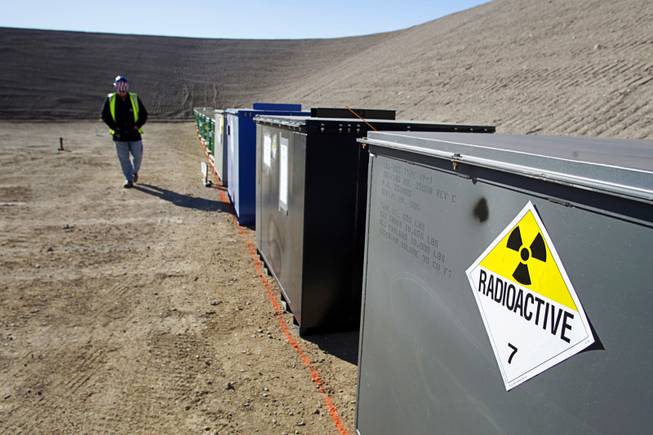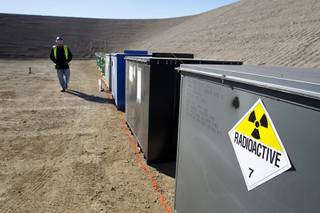
A worker walks by containers of mixed waste in the Area 5 Radioactive Waste Management Site of the Nevada National Security Site (N2S2), previously the Nevada Test Site, about 65 miles northwest of Las Vegas on Feb. 1, 2011.
Published Thursday, Nov. 14, 2013 | 2:31 p.m.
Updated Thursday, Nov. 14, 2013 | 3:22 p.m.
Related stories
- Radioactive waste to be shipped to Nevada site starting in 2014
- DOE slow to respond to Nevada lawmakers’ nuclear waste concerns
- Sandoval assails planned waste shipments, citing ‘dirty bomb’ fears
- Feds study feasibility of shipping radioactive waste through Las Vegas
- Yucca Mountain or not, nuclear waste resides here
- How nuclear waste gets to Nevada, and where it goes
- State releases memos detailing negotiations on pending nuclear waste shipment
- Titus demands answers on nuclear waste routes through Las Vegas Valley
- More political news
Hundreds of canisters of nuclear waste appear destined for the Nevada National Security Site, about 65 miles north of Las Vegas.
The waste, currently housed at Oak Ridge, Tenn., is highly radioactive. It could be used to help create a nuclear bomb, and it could travel on trucks through metropolitan Las Vegas.
Nevada elected officials, including Gov. Brian Sandoval, Sen. Harry Reid, and Congresswoman Dina Titus, have strongly objected, and Sandoval met with the head of the Energy Department earlier this year.
The Energy Department this week conducted a public relations blitz in Nevada, holding a teleconference with the press and two meetings in Las Vegas and Pahrump to discuss the proposal further and try to win public acceptance.
Here’s the gist of what was discussed at the meeting:
What, exactly, is inside of these radioactive canisters?
The 403 canisters that would arrive in 50-100 separate shipments during the next few years contain a lot of stuff.
The waste, technically called the Consolidated Edison Uranium Solidification Project, is a caustic cocktail of different radioactive elements.
For the scientists out there, the radioactive elements of the canisters are 76 percent uranium 235, about 10 percent uranium 233, and a mix of uranium 232, 234, 238 and 236. The canisters have been “downblended” to dilute the uranium and include other elements such as gadolinium nitrate and cadmium.
Will this radioactive waste pass through metropolitan Las Vegas?
We’re not being told. That information is classified.
If this stuff is so highly radioactive, why does the Energy Department call it “low-level waste”?
The Energy Department knows the stuff in these canisters is highly radioactive.
“Since it is highly radioactive, workers (or terrorists) engaged in the removal and processing of this material would be subject to high radiation doses,” DOE officials wrote in an email to Senate Majority Leader Harry Reid’s office.
But the legal definitions of waste don’t necessarily describe the canisters in layman’s terms.
Congress defines low-level radioactive waste based on what it’s not.
It is not spent fuel rods from nuclear power plants, man-made waste used by the military or products made by the processing of spent fuel.
Everything else is defined as low-level waste, even if, as would be the case here, the material would expose someone to unhealthy doses of radiation within minutes.
“That’s the rub,” Jim Haber of Las Vegas said at Wednesday’s town hall meeting. “That seems either dishonest or cavalier. It’s hard to trust, and it goes against logic when it has to be handled remotely (because it is so radioactive) and it’s called ‘low-level waste.’”
Can the Energy Department dump this stuff in Nevada over the state’s objections?
Yes. The Energy Department owns the waste land where they would bury these canisters and they have congressional authority under the Energy and Water Appropriations Act of 2006 to dispose of the waste where they see fit. That trumps Nevada’s objections.
When will the shipments begin?
“We would preferably like to get started with this campaign early in the next calendar year,” Mark Whitney, manager of the Oak Ridge Office of Environmental Management, said during a press call earlier this week.
But the Energy Department has spent the past few days clarifying this remark.
“No decisions have been made,” said Brad Crowell, assistant secretary for intergovernmental and congressional affairs at the Energy Department.
In fact, the Energy Department has been pushing for more than two years to bring the waste to Nevada, according to documents obtained by the Sun.
Where are Reid and Sandoval on this?
“It’s highly likely DOE wouldn’t do this or move over the objections of the senior senator of the state and the governor, but if they do choose to do that, then that’s a decision that they’re going to have to think long and hard about,” Reid spokeswoman Kristen Orthman said.
Wednesday's public meeting appears to have had little effect on Reid.
“Following yesterday’s public meeting, I remain concerned about DOE’s plans to store Consolidated Edison Uranium Solidification Project (CEUSP) canisters at the Nevada National Security Site (NNSS)," he said in a statement. "With the information I have today, I still do not support the transportation of these canisters. I’m pleased that DOE and the governor’s office continue discussions on this proposal through the working group. My office will remain apprised of these discussions.”
Sandoval called the meetings productive, but his office didn't elaborate further.
“The working group created between DOE and the state of Nevada has provided an unprecedented level of communication between the two entities,” said Mary-Sarah Kinner, spokeswoman for the governor. “Conversations are ongoing, and both the DOE and the state continue to work toward addressing the state's outstanding concerns.”
If they bury this highly radioactive waste here, would this open the door to even more highly radioactive waste coming here?
That’s a concern from state and local officials. Whitney said Wednesday that the Nevada National Security Site has accepted 46 shipments with higher radiation levels than these 403 canisters during the past 20 years.
State officials say these forthcoming shipments are different because they contain bomb-grade material.
Why not just leave the waste where it is in Tennessee?
The Energy Department says there’s no productive use for the radioactive materials in the canisters, so it needs to be disposed of. They picked the Nevada National Security Site for the area’s arid climate, physical isolation and existing security infrastructure.
Whitney said the budget to move these 403 canisters is $35 million a year, and the project will take between 18 months and three years to complete.
What answers do Nevada officials want from the Energy Department?
They want to know what would happen in the event of an emergency during transportation of this radioactive waste. Who would respond? Who would be in charge of the emergency?
They also want to know whether the energy department changed rules and regulations to allow this material into Nevada.


Join the Discussion:
Check this out for a full explanation of our conversion to the LiveFyre commenting system and instructions on how to sign up for an account.
Full comments policy